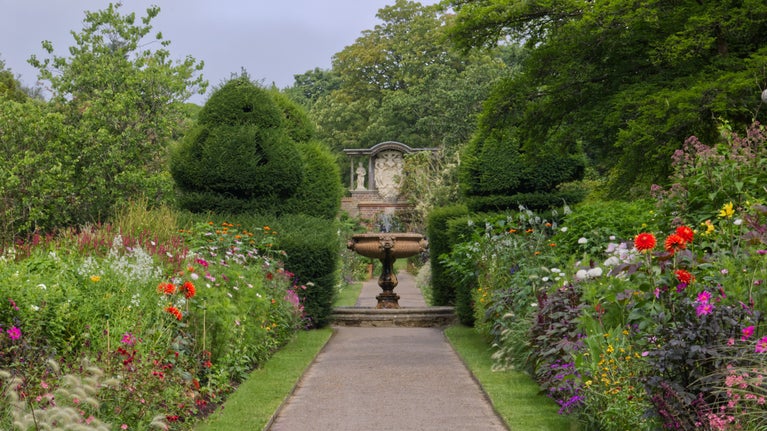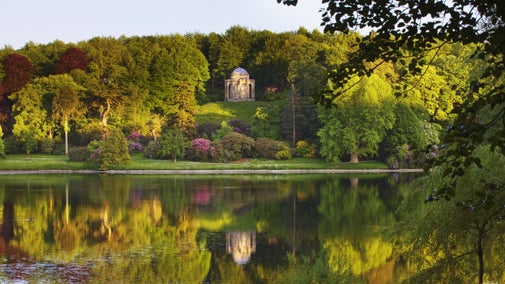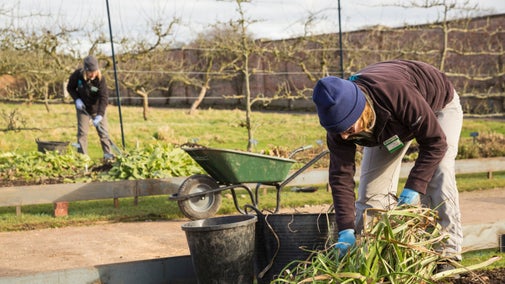
Gardens and landscapes
Find out more about the historical landscapes that the talented garden teams work hard to conserve at the places you love to visit.

The English landscape garden is characterised by structured informality. Orderly, aesthetically arranged elements draw attention to local flora and landscape features which appear entirely natural, or even ‘wild’.
The English landscape garden tradition goes back to the later sixteenth and early seventeenth-centuries. The Tradescants (John the elder, 1570–1638; John the younger, 1608–1662) collaborated with William and Robert Cecil and Sir Francis Bacon on garden designs that combined botanical discoveries from New World exploration with the discipline of natural history.
With the Glorious Revolution of 1688, William III brought a freer Dutch gardening style to England. Whilst the earlier Stuart monarchs had embraced the formal gardens of the French court, it now became fashionable to create gardens that rejected authoritarian formality in favour of rustic simplicity.
Ancient Greek notions of the Arcadian pastoral landscape influenced early eighteenth-century landscape gardens, but in a more natural style than that of French neoclassicism. Lancelot 'Capability' Brown (1715–1783) designed gardens at Stowe and Chatsworth in this style, creating serpentine water features, elegant vistas, rustic Greek temples, and natural-looking treescapes.

As the picturesque came to be valued in the later eighteenth-century, the pastoral gave way increasingly to the wild and Romantic. Humphry Repton (1752–1818) and his contemporaries in the late eighteenth and early nineteenth centuries began to add artificial ruins and wildernesses to the gardens at Blaise Castle and Woburn Abbey.
The landscape garden continued to evolve over the nineteenth and twentieth centuries with the Arts and Crafts movement’s turn toward the cottage garden, which combined function with aesthetic appeal. This culminated in Gertrude Jekyll’s designs at Munstead Wood and in Vita Sackville-West’s garden at Sissinghurst Castle.

At every point in the history of English landscape design, the garden was invested with political meaning. To garden in the informal style after the Glorious Revolution was to state opposition to Stuart tyranny, whilst Capability Brown’s eighteenth-century pastoral gardens expressed the polite civility to which England’s landed classes aspired.
Repton’s Romantic landscapes embraced the savage freedom of the natural world, which hinted at social and political disruption. The Arts and Crafts garden style was a rejection of industrial England and an attempt to restore the landscape to a pre-industrial ideal.
This article contains contributions from Allison Adler Kroll from the University of Oxford who specialises in English literature, history, and culture from 1800 to the present day, and also has research interests in political history and theatre. Allison is a contributor to the Trusted Source project.

Find out more about the historical landscapes that the talented garden teams work hard to conserve at the places you love to visit.

A hub for multi-disciplinary research projects and research engagement at the University of Oxford
Find out more about our Trusted Source articles, which were created in partnership with the University of Oxford, and explore topics related to the special places in our care.

Explore how changing tastes influenced the style of gardens over the centuries and discover where you can find the best examples from each period at the places we care for.

Find out how water gardens have evolved with changing tastes, from European inspiration and ornamental canals to the water feature in your garden today.

Discover the evolution in garden buildings, from exclusive hothouses for rare new finds to the cornerstones of every garden today.

Discover some of the finest historic gardens in our care and how they were shaped by Victorian plant collectors, as they gathered plant species from across the globe.

Discover our gardeners’ top tips so you can make the most of your garden, plot or window box.

We care for hundreds of historic gardens, encompassing more than 500 years of history and a range of garden styles and fashions. Learn about the most famous and significant gardens you can visit.

Explore Claremont Landscape Garden in Surrey in our podcast episode 'A garden fit for Bridgerton' to uncover historic parties described as the lovechild of a music festival and a garden party. You can also find more episodes from series seven, filled with nature and history.
